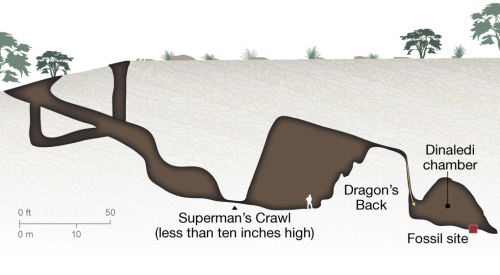For the full article see: This Face Changes the Human Story. But How?
By Jamie Shreeve, National Geographic, Photographs by Robert Clark
September 10, 2015
A trove of bones hidden deep within a South African cave represents a new species of human ancestor, scientists announced Thursday in the journal eLife. Homo naledi, as they call it, appears very primitive in some respects—it had a tiny brain, for instance, and apelike shoulders for climbing. But in other ways it looks remarkably like modern humans. When did it live? Where does it fit in the human family tree? And how did its bones get into the deepest hidden chamber of the cave—could such a primitive creature have been disposing of its dead intentionally?
This is the story of one of the greatest fossil discoveries of the past half century, and of what it might mean for our understanding of human evolution.
Two years ago, a pair of recreational cavers entered a cave called Rising Star, some 30 miles northwest of Johannesburg. Rising Star has been a popular draw for cavers since the 1960s, and its filigree of channels and caverns is well mapped. Steven Tucker and Rick Hunter were hoping to find some less trodden passage.
In the back of their minds was another mission. In the first half of the 20th century, this region of South Africa produced so many fossils of our early ancestors that it later became known as the Cradle of Humankind. Though the heyday of fossil hunting there was long past, the cavers knew that a scientist in Johannesburg was looking for bones. The odds of happening upon something were remote. But you never know.
eep in the cave, Tucker and Hunter worked their way through a constriction called Superman’s Crawl—because most people can fit through only by holding one arm tightly against the body and extending the other above the head, like the Man of Steel in flight. Crossing a large chamber, they climbed a jagged wall of rock called the Dragon’s Back. At the top they found themselves in a pretty little cavity decorated with stalactites. Hunter got out his video camera, and to remove himself from the frame, Tucker eased himself into a fissure in the cave floor. His foot found a finger of rock, then another below it, then—empty space. Dropping down, he found himself in a narrow, vertical chute, in some places less than eight inches wide. He called to Hunter to follow him. Both men have hyper-slender frames, all bone and wiry muscle. Had their torsos been just a little bigger, they would not have fit in the chute, and what is arguably the most astonishing human fossil discovery in half a century—and undoubtedly the most perplexing—would not have occurred….
…After contorting themselves 40 feet down the narrow chute in the Rising Star cave, Tucker and Rick Hunter had dropped into another pretty chamber, with a cascade of white flowstones in one corner. A passageway led into a larger cavity, about 30 feet long and only a few feet wide, its walls and ceiling a bewilderment of calcite gnarls and jutting flowstone fingers. But it was what was on the floor that drew the two men’s attention. There were bones everywhere. The cavers first thought they must be modern. They weren’t stone heavy, like most fossils, nor were they encased in stone—they were just lying about on the surface, as if someone had tossed them in. They noticed a piece of a lower jaw, with teeth intact; it looked human.
…
The bones were superbly preserved, and from the duplication of body parts, it soon became clear that there was not one skeleton in the cave, but two, then three, then five … then so many it was hard to keep a clear count. Berger had allotted three weeks for the excavation. By the end of that time, the excavators had removed some 1,200 bones, more than from any other human ancestor site in Africa—and they still hadn’t exhausted the material in just the one square yard around the skull. It took another several days digging in March 2014 before its sediments ran dry, about six inches down.
There were some 1,550 specimens in all, representing at least 15 individuals. Skulls. Jaws. Ribs. Dozens of teeth. A nearly complete foot. A hand, virtually every bone intact, arranged as in life. Minuscule bones of the inner ear. Elderly adults. Juveniles. Infants, identified by their thimble-size vertebrae. Parts of the skeletons looked astonishingly modern. But others were just as astonishingly primitive—in some cases, even more apelike than the australopithecines. “We’ve found a most remarkable creature,” Berger said. His grin went nearly to his ears.
______________________
The above is an except from the excellent National Geographic article on this discover. To read one of the actual scientific papers itself, see:
Homo naledi, a new species of the genus Homo from the Dinaledi Chamber, South Africa
Abstract: Homo naledi is a previously-unknown species of extinct hominin discovered within the Dinaledi Chamber of the Rising Star cave system, Cradle of Humankind, South Africa. This species is characterized by body mass and stature similar to small-bodied human populations but a small endocranial volume similar to australopiths. Cranial morphology of H. naledi is unique, but most similar to early Homo species including Homo erectus, Homo habilis or Homo rudolfensis. While primitive, the dentition is generally small and simple in occlusal morphology. H. naledi has humanlike manipulatory adaptations of the hand and wrist. It also exhibits a humanlike foot and lower limb. These humanlike aspects are contrasted in the postcrania with a more primitive or australopith-like trunk, shoulder, pelvis and proximal femur. Representing at least 15 individuals with most skeletal elements repeated multiple times, this is the largest assemblage of a single species of hominins yet discovered in Africa.




